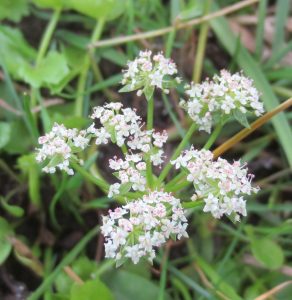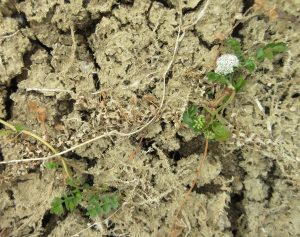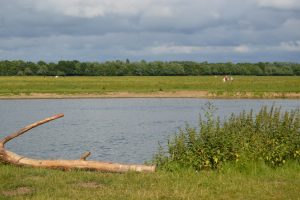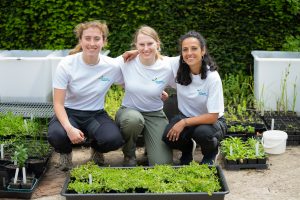The race against time to save Creeping Marshwort
19th October 2022
Freshwater Habitats Trust Freshwater Futures Trainee Paola Perez explains how we are helping to bring endangered wetland plant Creeping Marshwort back from the brink of extinction.
One location in Oxford was, until recently, the only place in the UK where Creeping Marshwort could be found. Thanks to the work of conservationists and volunteers, this plant is now growing at sites in London, Norfolk and Oxford.
Species in the spotlight
 White umbels of Creeping Marshwort
White umbels of Creeping Marshwort
Creeping Marshwort (Helosciadium repens) is a small member of the carrot family (Apiaceae). It spreads along the ground by stolons (long stems that grow close to the ground, like strawberry runners) and produces pinnate leaves, comprised of between three and seven leaflets. The leaflets are opposite and shallow-toothed, save for one deep indentation.
From late July to November, the plant produces an inflorescence of delicate white umbels. It can easily be confused with similar-looking members of the carrot family, especially Fool’s Watercress (Helosciadium nodiflorum). If you think you have found Creeping Marshwort, look closely at the shape and degree of toothing or notching of the leaves, the peduncle (stalk of the flower) length and the number of bracts (leaf-like structures beneath the flowers). But beware – hybrids between Creeping Marshwort and Fool’s Watercress have been seen in the Oxford area.
Creeping Marshwort lives in flood-prone pastures where water levels tend to drop rapidly in late spring, resulting in large areas of bare damp mud. This species needs a lot of light and thrives where livestock grazing keeps grasses and other more competitive plants under control.
Why is Creeping Marshwort so rare?
Because of its rarity and decline in Europe, Creeping Marshwort is a species of European conservation concern and one of the few such plants that occurs in the UK. Populations are strictly protected by several pieces of UK legislation and its status has been raised to Critically Endangered, meaning it is imminently threatened with extinction in the country.
 Creeping Marshwort in a pond margin during a drought event. Photo by Judy Webb.
Creeping Marshwort in a pond margin during a drought event. Photo by Judy Webb.
Historic records for the plant only a small number of locations, including sites in Yorkshire, the Mull of Kintyre and Oxfordshire. However, it is only the Oxfordshire records that are substantiated with preserved specimens.
One reason for its scarceness is that it won’t persist in sites without adequate livestock grazing (or, alternatively, continuous cutting and raking). Nevertheless, the balance of grazing needs to be just right and excessive trampling through over-grazing can eliminate entire populations.
In addition, it needs moist soil, so its populations can fluctuate from year to year, depending on weather conditions. It is believed that the species is vulnerable to climate change: extreme flooding events have temporarily wiped out some populations. Years of increased spring and summer rainfall also favour the growth of competitive grasses over Creeping Marshwort, while in hot and dry summers, plants do not survive long enough to flower and produce seeds.
At Port Meadow in Oxfordshire, populations are also threatened by the arrival in the 1990s of New Zealand Pygmyweed Crassula helmsii, an extremely invasive non-native species.
Why did Port Meadow retain its Creeping Marshwort population?
 Port Meadow across the River Thames. Photo by N Chadwick CC BY-SA 2.0.
Port Meadow across the River Thames. Photo by N Chadwick CC BY-SA 2.0.
Port Meadow lies in the floodplain of the River Thames in Oxford. It is, in fact, not a meadow, but an area of pasture that has been grazed for over a millennium by commoners’ cows and horses, as well as flocks of wildfowl. The site forms part of one of Europe’s most important complexes of floodplain grassland, the Oxford Meadows Special Area of Conservation (SAC). Port Meadow is included within the SAC because of its Creeping Marshwort population.
Populations held on at Port Meadow when they had been lost everywhere else. This is thought to be because of the continuity of grazing by large animals there, together with it being a large and relatively unmodified area of the Thames’ natural floodplain. Though small, Creeping Marshwort is therefore a precious relic of the Thames’ ancient and wilder past.
The return of Creeping Marshwort to Walthamstow and Thetford
In recent years, we have seen Creeping Marshwort growing at two new British sites.
Habitat management at Walthamstow Marshes in the Lee Valley Regional Park in East London resulted in the surprise appearance of Creeping Marshwort in 2002. Though it had never been seen in the area, plants are thought to have grown from buried seed, which was able to germinate once taller vegetation was eliminated. Efforts were made to encourage its growth, but sadly the population was lost in 2012. This was possibly due to changes in water levels, unfavourable grazing patterns and competition from more vigorous vegetation. The plant could not be found at the site for the next eight years.
 Walthamstow Marsh Nature Reserve with cattle grazing. Photo by Stu Smith CC BY-ND 2.0.
Walthamstow Marsh Nature Reserve with cattle grazing. Photo by Stu Smith CC BY-ND 2.0.
However, in 2020 the species reappeared in the after repeated cutting and clearing of these areas by park staff and volunteers. To protect the patches of Creeping Marshwort from being trampled, the team erected temporary wire fences and placed baskets over plants. Under Natural England license, they have also taken cuttings from plants to be cultivated off-site and reintroduced when conditions are right.
A similar remarkable story took place in Nuns Bridge in Thetford, Norfolk, where a newly-created scrape brought Creeping Marshwort back from the seedbank in 2020. Thetford Conservation Group volunteers discovered the plant after the scrape was dug in an area that was previously dominated by tall weeds and nettles. It has recently been found to have spread downstream.
Botanists have collected seeds from all three known populations, which are preserved for safe-keeping at the Royal Botanic Garden’s Millennium Seed Bank. Experts believe that the Thetford population could be genetically distinct and therefore of great importance to future conservation efforts.
Saving Creeping Marshwort in Oxfordshire
Freshwater Habitats Trust has been supporting the conservation of this rare plant in Oxfordshire since the 1990s. The first successful introduction of Creeping Marshwort was done by The Oxfordshire Flora Group (then the Rare Plants Group) in 1996, to Willow Walk in North Hinksey. The plants for introduction were grown from Port Meadow seed at the Oxford Botanic Garden.
 Judy Webb planting Creeping Marshwort.
Judy Webb planting Creeping Marshwort.
We’re now working with Oxford-based conservationist and ecologist Dr Judy Webb BEM to introduce Creeping Marshwort to sites in Oxfordshire. Judy is the Flora Guardian for this species in the Oxfordshire Flora Group (part of the Ashmolean Natural History Society of Oxfordshire) and studies Creeping Marshwort populations as well as supervising and overseeing this species’ management on Oxfordshire’s new introduction sites.
Her work with Creeping Marshwort, in partnership with Natural England, Oxford City Council, and Oxford Botanic Garden, among others, has seen the plant introduced to a further five sites in Oxfordshire from plant material extracted under licence from the original Port Meadow population.
Although the lack of appropriate grazing (or of continuous cutting and clearing) has affected some reintroductions, great progress has been made in safeguarding and improving the survival chances of this species. Moreover, a totally new patch of Creeping Marshwort, likely colonised by seed, has been reported near to one of the introduction sites, giving us hope for a better future for this plant in Oxfordshire.
Introducing Creeping Marshwort through GroWet
Freshwater Habitats Trust’s new project, Building Oxfordshire’s Freshwater Network, aims to protect freshwater wildlife by creating a national network of healthy, unpolluted and interconnected freshwater landscapes.
A major part of this project is GroWet, an initiative that has seen more than 450 local volunteers growing rare wetland plants at home. These plants will soon be introduced to high-quality habitats in Oxfordshire with the aim to boost their populations in the wild.
We hope that adding specimens to local sites will help Oxford’s Creeping Marshwort populations, boosting its numbers and contributing to the efforts of Judy and everyone else involved in the conservation of this amazing little plant.
 Left to right: Elinor MacDonald, Lizzie Every and Paola Perez at Oxford Botanic Garden with Creeping Marshwort propagules before their distribution to GroWet volunteers.
Left to right: Elinor MacDonald, Lizzie Every and Paola Perez at Oxford Botanic Garden with Creeping Marshwort propagules before their distribution to GroWet volunteers.
How you can help
If you want to help us to bring Creeping Marshwort back from the brink of extinction in Oxfordshire, here are a few ways in which you can help.
- Look out for volunteering opportunities through our Building Oxfordshire’s Freshwater Network
- Join the Oxfordshire Fens Project, where local experts, landowners and volunteers work together towards the survival of Oxfordshire’s threatened wetland species.
- Volunteer with the Oxfordshire Fens Project. Email Sally at gillard17@gmail.com
Thanks to Judy Webb, Eammon Lawlor and Ian Woodward for their contribution to this blog.
